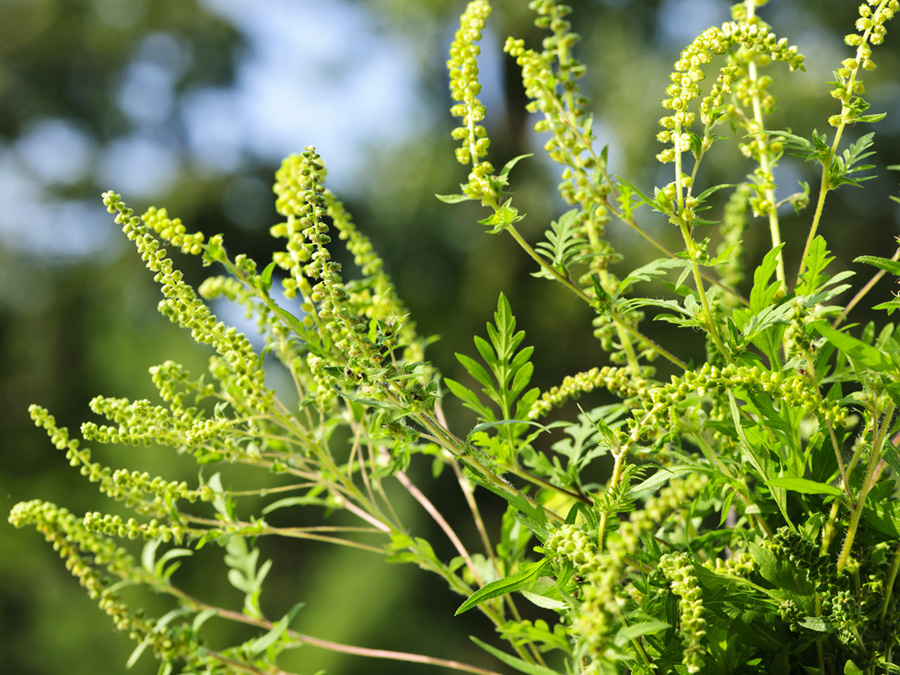Study reveals what makes ragweed pollen so allergenic
Adenosine in Ambrosia pollen increases allergic response

Ragweed only started to become widespread in the last few decades. To date, the major allergen within its pollen was thought to be the protein Amb a 1. This is because the majority of humans that come into contact with ragweed pollen develop antibodies against this protein – one of the body’s protective mechanisms against undesirable substances or pathogens. In an allergic reaction, though, these antibodies are produced unnecessarily.
New experimental disease model for allergic symptoms
If ragweed pollen enters the airways, it triggers a strong inflammatory reaction in the lung tissue, which can result in respiratory problems or even asthma. A team led by Prof. Claudia Traidl-Hoffmann, TUM Chair for Environmental Medicine (UNIKA-T), and Prof. Carsten Schmidt-Weber, Director of the Center of Allergy and Environment (ZAUM) – a cooperation between TUM and the Helmholtz Zentrum München – has now investigated these allergic responses for the first time with an experimental disease model they developed. The scientists used this to test how individual components of the pollen affected pulmonary tissue.
Describing the findings, Dr. Maria Wimmer, one of the study’s main authors together with Dr. Francesca Alessandrini, explains: “We were able to show that the major allergen Amb a 1 barely triggered inflammation on its own – in contrast to the whole pollen extract, which was highly allergenic.”
Pollen-derived adenosine exacerbates allergic reaction
The experimental disease model entailed intranasal instillation of different pollen components over eleven days. The researchers then examined the lungs for signs of inflammation, including the presence of specific immune cells in the tissue. During this study, the whole pollen extract, just the protein Amb a 1 or a protein-free fraction of the pollen extract were applied.
“Contrary to our expectations, only the whole extract produced an allergic reaction. This led us to assume that another substance besides Amb a 1 is responsible for the pollen’s effect,” reveals Alessandrini. In their efforts to identify a possible candidate, the scientists were aided by one of their own previous studies in which a high concentration of adenosine was detected in birch pollen. “Large amounts of adenosine are also present in ragweed pollen, making this a promising avenue of investigation,” adds the researcher.
To test this hypothesis, the scientists removed adenosine from the whole pollen extract and administered the mixture again. Only minimal signs of inflammation were detected as a result. Giving adenosine on its own also triggered no clear allergic reaction in the lungs.
Adenosine receptor antagonists to treat allergic asthma?
Adenosine also occurs naturally in the human body and is involved in many different processes – the surface of almost every cell thus features dedicated recognition molecules. “Exactly how adenosine aggravates allergies is something we have yet to determine. Evidently, though, pollen-derived adenosine binds to the body’s own receptors and can trigger allergies in combination with other substances,” clarifies Wimmer.
Experimental studies have already demonstrated that adenosine receptor antagonists can aid the treatment of asthma by blocking the body’s adenosine receptors. Summarizing upcoming scientific plans, Wimmer concludes: “Since our study shows that adenosine is a decisive factor in ragweed allergy, our next aim is to test whether these substances can relieve or prevent asthmatic symptoms here too.”
Original publication
M. Wimmer, F. Alessandrini, S. Gilles, U. Frank, S. Oeder, M. Hauser, J. Ring, F. Ferreira, D. Ernst, J. B. Winkler, P. Schmitt-Kopplin, C. Ohnmacht, H. Behrendt, C. Schmidt-Weber, C. Traidl-Hoffmann, J. Gutermuth, Pollen-derived adenosine is a necessary cofactor for ragweed allergy, Allergy, May 2015.
DOI: 10.1111/all.12642
Contact
Dr. Maria Wimmer
Scientist, Institute of Environmental Medicine, UNIKA-T
Technische Universität München and Helmholtz Zentrum München
Phone: +49 (89) 3187-3061
E-mail: maria.wimmer@helmholtz-muenchen.de
Dr. Francesca Alessandrini
Scientist, Center of Allergy and Environment (ZAUM)
Technische Universität München and Helmholtz Zentrum München
Phone: +49 (89) 3187-2524
E-mail: franci@helmholtz-muenchen.de
Technical University of Munich
Corporate Communications Center
- Dr. Vera Siegler
- vera.siegler@tum.de
- presse@tum.de
- Teamwebsite